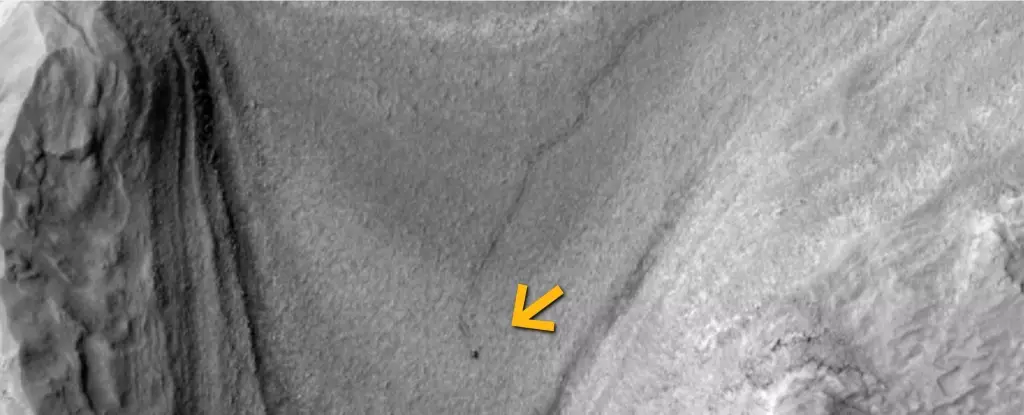Since its launch in August 2012, NASA’s Curiosity rover has embarked on an epic journey across the desolate landscape of Mars. Unlike any explorer before it, Curiosity carries the hopes and dreams of humanity, acting as an ambassador of Earth on a distant world. As it traverses the Gale Crater, this mechanical marvel has opened a treasure trove of knowledge about the geological and historical context of Mars. The rover embodies an exploration ethos that is inherently human: the quest to uncover the mysteries of a realm that is both similar to and starkly different from our own.
The stark image recently sent back by NASA’s Mars Reconnaissance Orbiter showcases Curiosity’s solitude in this alien environment. Viewed from above, the rover appears merely as a tiny blip against the otherworldly Martian terrain, with its tracks snaking through the sand like a whisper of its journey. This particular photograph may mark a significant milestone, as it potentially represents the first instance where a Mars orbiter has captured an active rover in motion. The fleeting nature of these tracks, destined to be erased by Mars’ capricious winds, puts into perspective the ephemeral nature of exploration itself.
The Slow and Steady Approach
Curiosity’s cautious pace—averaging only 160 meters per hour—serves as a poignant metaphor for the intricacies of space exploration. While to an average human, this speed may seem excruciatingly slow, for Curiosity, it is a calculated maneuver aimed at ensuring precision in its scientific endeavors. Powered by a modest 110-watt nuclear generator, the rover must conserve energy while delicately navigating the rugged Martian terrain. The slow crawl is not just a strategic necessity but a testament to the intelligent design behind robotic exploration.
Despite having covered only 34.59 kilometers in its lifetime, Curiosity’s journey is marked by monumental discoveries. Each inch it travels is laden with meaning, revealing tantalizing clues about Mars’ watery past. The recent exploration along the Gediz Vallis channel highlighted Curiosity’s ability to dissect geological formations, where massive floods once scoured the landscape, leaving behind fascinating clues to the planet’s climatic history. The sulphur deposits uncovered within this dry riverbed are particularly intriguing and could hint at past biological processes—or at the very least, the environmental conditions that might have supported such phenomena.
Unveiling the Geological Riches
As Curiosity climbs the iconic slopes of Mount Sharp, it introduces us to increasingly complex geological formations. The rover has explored a range of features, including Devil’s Gate and the Santa Ynez region, where its sensors and cameras have documented layers akin to geological strata on Earth. The sheer diversity of soils and rock types suggests not just a violent past characterized by water activity, but also a dynamic environment capable of supporting life.
One particularly striking formation Curiosity is headed for is the boxwork structure—a fascinating geological curiosity characterized by its intricate web of ridges. Here on Earth, boxwork formations result from mineral deposits lining fractures in the rock, remnants of a time when groundwater flowed freely. The possibility that similar processes have occurred on Mars adds another layer to the planet’s story, especially as scientists consider the implications this has for ancient microbial life. If the conditions beneath the surface were once warmer and wetter, could they have harbored life? The enduring anticipation surrounding these inquiries highlights the captivating intersection of geology and astrobiology.
A Symbol of Human Endeavor
The Curiosity rover exemplifies the resilience and ingenuity that mankind is capable of. It is not merely a hunk of metal wandering an alien desert; it symbolizes our unyielding spirit to explore the unknown. Each data point it collects, every image it sends back, is a testament to countless hours of effort and dedication from engineers, scientists, and dreamers alike. As Curiosity continues its mission, it remains a beacon of curiosity, urging humanity to reach farther and dream bigger in our quest to understand our place in the cosmos. Through its mechanical eyes, we glimpse not just the character of Mars but also the possibilities that lie ahead for all who dare to explore.

